Why is it necessary to systematically inspect LPG installations?
Regular inspections of the gas system are very important for safety, trouble-free driving, and more efficient fuel consumption. Unfortunately, many drivers forget that systematic inspections are necessary for the proper operation of the LPG system. Find out why you should systematically check the condition of LPG installations.
LPG autogas system inspections – why are they so important?
Regular inspections are necessary for the proper operation of the LPG system. During such inspection visits (including warranty visits), specialists carry out diagnostics of the gas system. This is only possible with the appropriate hardware and software, so you need to go to a workshop that has this type of equipment. And if the visit takes place as part of warranty inspections – go to the guarantor, i.e. to the workshop that installed the installation. A comprehensive assessment of the efficiency of the installation is then performed. Specialists check: the tightness of the multivalve, the tightness of the reducer, the tightness of the injectors and the tightness of the connection pipes. They also check whether the injection map has become worn during use. In addition, filters of the liquid and volatile phases are replaced.
In this way, it is also possible to detect possible faults early and then take appropriate measures to repair them. This is the best way to avoid more serious problems. And the bigger the problem, the bigger the expenses. Moreover, driving with components that may fail to obey at any time is a huge risk, posing a threat to both the driver and passengers as well as other road users. So if you care about the efficiency of the gas system and the safety of your vehicle, take care of regular inspections. In this case, the saying that “prevention is better than cure” works perfectly.
How often should I inspect LPG autogas installation?
This is the most frequently asked question by owners of vehicles equipped with an LPG installation. At the beginning, it is worth checking the warranty card issued by the installer and carrying out inspections in accordance with the intervals specified in the card. The frequency of inspections depends primarily on the type of installation, as well as the quality of the gas you are refueling. The most common inspections are carried out on the occasion of filter replacement. This is usually every 10-15-20 thousand. km. Where did the discrepancies come from? Because it all depends on the specifics of the installation itself mounted on the vehicle. So let’s follow the manufacturer’s recommendations. As a standard, however, a reasonable solution, especially after the end of the warranty period, seems to carry out inspections at least once a year or just every 10-20 thousand km.
(Translated using the Google Translate tool)

